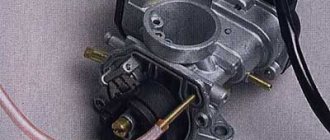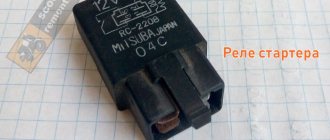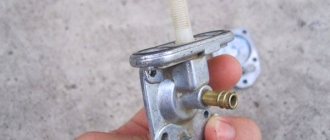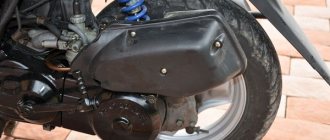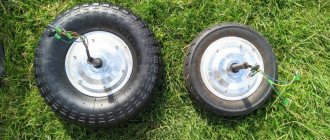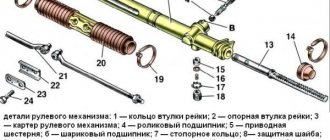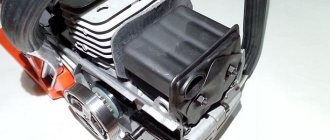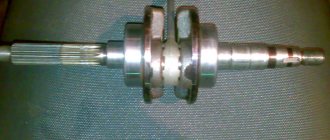Almost every scooter owner has at least once encountered a problem: the scooter will not start. This problem especially often occurs with the onset of cold weather.
In such situations, two questions arise: why and what to do?
In this article we will answer these questions, look at the main causes of the problem and figure out what to do in such situations.
Reasons for lack of spark
Often, owners may encounter cases of starting failure in the cold season, although the moped drove well in the autumn. Initially, you need to unscrew the spark plug and carefully inspect for spark, oiliness and color.
Carbon deposits on the electrode
There may be no spark, if the electrode is covered with carbon deposits, then they are cleaned with a metal brush. If there is even the slightest doubt about the serviceability of the spark plug, you should replace it immediately, thereby making your life easier in the future.
Acidification of contacts
If the external signs of the spark plug correspond to suitability, and there is also no spark, then you need to check whether there is a discharge. It is worth noting that you need to be extremely careful, as it can give you an electric shock. If there is no spark and the external signs of the spark plug are normal, then the scooter is checked electronically for acidification of the contacts.
Insufficient fuel
If there is a spark, but the moped still has difficulty starting from the starter in cold weather, you should pay attention to the fuel tank. If it is empty then it is filled
It is worth noting why old gasoline pours out of the carburetor float chamber. How to do it? There is a bolt at the bottom of the carburetor; it is unscrewed, and after all the fuel has flowed out, it is screwed back in. Before putting the moped in the garage in cold weather, fill the tank full of fuel.
Unscrew the bolt and pour out the old gasoline from the carburetor float chamber
If the above has been checked and done, and the scooter does not start well from the starter, then you can make the following repairs:
- The carburetor is removed and the air filter is cleaned;
- The carburetor is cleaned, the jets and channels are purged;
- Everything is coming back together.
Troubleshooting
Malfunctions of electrical equipment and fuel systems are the most regular of all problems that arise among scooter owners.
It often happens that a breakdown suddenly occurs to the scooter. Repairing the carburetor, as a rule, allows you to resume the functioning of your “faithful horse”.
Usually, to do this, it is enough to remove the carburetor, clean the dust from the outside and the tarry deposits of gasoline and other debris inside. Clean and blow out the air and fuel channels and jets, check the condition of the fuel needle and throttle valve, and then reassemble and adjust it.
Fixing more complex breakdowns at home is not always possible, since specific tools are often required that are not widely available.
Thus, for a technically literate person, repairing a scooter with your own hands will not be very difficult if you have minimal knowledge and skills in handling equipment, as well as the necessary tools.
002_moto_1211_080
GET IN - IT WILL NOT KILL! Some citizens believe that when repairing or diagnosing electrical wiring, you can get an electric shock. It's in vain. Modern motorcycles (as well as cars) have a voltage of 12 V. This voltage is absolutely safe for humans, for example, if you hold both poles of the battery even with wet hands, you will not feel anything. The only exception is the ignition system, where the voltage in the secondary circuit (armored wire - spark plug) reaches tens of thousands of volts. Here it is better not to grab with wet bare hands, although I have never heard of cases of a person receiving any injury from a high-voltage motorcycle wire. Conclusion: there is no need to be afraid of working with motorcycle electrics. Any household appliance operating on a 220 V network is much more dangerous.
If the engine does not start, it is not at all necessary to immediately “turn the switch” to the ignition system. Moreover, her refusals are extremely rare. Most often, the cause of failure to start is the wrong mixture: either too lean (when, for example, we start a motorcycle in the cold after a long break), or too rich (when on a hot engine the driver forgetfully pulled out the “choke” or after a fall, when gasoline leaks from the float chamber managed to “fill” the cylinder).
It also happens that during many attempts to start the motorcycle, the battery runs low and one malfunction is replaced by another: for example, the mixture may already be normal, but it is no longer possible to produce a spark when the battery voltage is low (and it can drop to 6 V during cranking with the starter) Maybe. In this case, before you disassemble anything, connect another battery to help or, if it is not there, try to start it with a kick.
MOTOUA.NET: Honda Dio AF 27 does not start with electric starter - MOTOUA.NET
- Forums
- Users
- Calendar
- MOTOUA.NET >FORUM
- >GARAGE: discussion, operation, repair and tuning of motorcycles
- >REPAIR AND OPERATION OF SCOOTERS (up to 49.9cc)
- Forum Rules
- NEW MESSAGES
Honda Dio AF 27 does not start with electric starter
#1 Lex745
- Participant
- Group: Users
- Posts: 41
- Registration: 09 September 08
- Up of the page up there ^
Other answers in this thread
#2 KipLinG
- Participant
- Group: Users
- Posts: 76
- Registration: 13 September 08
- Up of the page up there ^
#3 Lex745
- Participant
- Group: Users
- Posts: 41
- Registration: 09 September 08
KipLinG (9.7.2010, 22:19) wrote:
- Up of the page up there ^
#4 Nowhere
- Participant
- Group: Users
- Posts: 49
- Registration: 16 June 08
- Up of the page up there ^
#5 3BIP
- Old timer
- Group: administration
- Posts: 3,335
- Registration: 03 March 06
- Up of the page up there ^
#6 Lex745
- Participant
- Group: Users
- Posts: 41
- Registration: 09 September 08
- Up of the page up there ^
#7 3BIP
- Old timer
- Group: administration
- Posts: 3,335
- Registration: 03 March 06
- Up of the page up there ^
#8 Lex745
- Participant
- Group: Users
- Posts: 41
- Registration: 09 September 08
3BIP (10.7.2010, 14:02) wrote:
Post edited by Lex745: July 10, 2010 - 10:26
- Up of the page up there ^
#9 Ankoriji
- Participant
- Group: Users
- Posts: 294
- Registration: 06 May 08
Post edited by Ankoriji: 10 July 2010 - 12:16
- Up of the page up there ^
#10 Lex745
- Participant
- Group: Users
- Posts: 41
- Registration: 09 September 08
Ankoriji (10.7.2010, 17:35) wrote:
Post edited by Lex745: 10 July 2010 - 14:09
Where is the battery located on a moped and how to connect it?
Now that we know how to start a scooter without a battery, it will be useful to think about where the battery is located on a moped. After all, it’s not worth driving for a long time without it, in any case. It is better to understand this in advance so that in the future you will know how to connect the battery yourself.
If you have a Chinese scooter model, the battery is located directly under the footrest. You just need to remove it, find a small rectangular hatch, behind which the battery is located. With Japanese models the situation is a little more difficult: the battery in them can be placed not only under your feet, but also in front, and even under the seat of your two-wheeled friend. As a last resort, you should look for the battery in the underseat space.
If you received a moped without a battery, before purchasing, carefully measure the niche in which the battery should be located. Only then go to the store for a power source. As a last resort, you can start a moped using one of the above methods, come to the store directly on it, and the seller will definitely select the right model for you.
Connecting the battery must be started so that the terminals, when placed in a niche, are located as close as possible to the wires. If the wires come out from the left, install the battery, turning the terminals to the left.
Now take two nuts (they are usually square) and two bolts, which should be included with each battery. The nuts need to be inserted into the terminals and “tightened” with bolts. After that, find the red ones among the wires: one is thin and the other is thick. Their ends are connected to each other by a terminal - this is the positive pole. The green or black wire will definitely be the negative pole.
Connect the wires correctly: minus to minus, and plus to plus. Now check the operation of the moped: if everything is connected correctly, the motor will start.
Scooter won’t start – Scooter-Expert – online magazine about scooters and technology
There may be several reasons why the scooter does not start and the electric starter does not work at the same time; let’s look at the main ones:
- Let's say the battery is discharged or there is a problem in the circuit from the electric starter to the battery. You can try starting the scooter from kickstarter. However, if, after pressing the kick, it rotates freely, but does not rotate the crankshaft, you should check the condition of the teeth of the kick gear and ratchet. Perhaps after replacing the worn parts everything will be fine. Scooter won't start? Go ahead.
- The fuses could simply have blown. In this case, you should check the fuse (if one is used for the entire circuit), or several fuses, in particular the starter and ignition circuits. If they don't ring through, replace them.
- If the electric starter does not turn the crankshaft when you press the Start button, the battery may be dead. Check the battery. If it is discharged, you should start the scooter engine from the kickstarter and check the charge voltage; perhaps the battery has discharged due to incorrect charging current or due to its absence.
- If, after pressing the “Start” button, you hear the starter operating, but the crankshaft does not turn, you should definitely check the condition of the charter gears on the crankshaft and the adequacy of the starter overrunning clutch.
- You should also check the starter circuit for serviceability. Listen carefully to see if, after pressing the engine start button, you hear the characteristic clicks of the starter solenoid relay operating. If there are no clicks, you should use a tester to check the starter relay itself, the nearest electrical wiring, and the negative battery cable. Sometimes after cleaning the contacts of the battery or relay, the operation of the entire circuit is restored.
Now let's imagine a different situation. The battery is charged, after pressing the starter button, it cranks the crankshaft perfectly in normal mode, but the scooter does not start. In this case, the reasons are somewhat different, as are the options for solving the problem. Let's look at this point in more detail, identifying the main reasons why the scooter does not start when the electrics are running:
- Check the operation of the starting enrichment. If the problem is in the wiring of the concentrator, the problem can be solved only by soldering or replacing the wiring, but if the problem is in the starting concentrator itself, it is easier to replace it with a new one.
- If fuel does not flow from the gas tank to the carburetor float chamber, the scooter will not start precisely because of the lack of fuel. This may have been caused by a jammed needle valve in the carburetor float chamber. Remove the float chamber cover and check the operation of the shut-off needle.
- If your scooter is equipped with a fuel pump (devices with a bottom tank), the fuel pump may be faulty.
- The most basic thing is to check if there is fuel in the tank. Often even this point is ignored.
- Check to see if the fuel hose, filter, or fuel tap filter is clogged. This is where blowing the elements with compressed air helps.
- Check the vent hole in the gas cap (or elsewhere, depending on design).
- If there is a spark, but it is noticeably weaker than usual, the spark plug may be faulty. You should check the gaps between the electrodes, the contacts between the spark plug and the cap, as well as the battery voltage (for scooters that refuse to work without a working battery).
- There may be no spark at all. In this case, replacing the spark plug with a new one often helps.
- Check the air filter; it may be in critical condition and does not allow air to pass through to form a normal fuel-air mixture.
- Check to see if there is any air leaking into the carburetor bypassing the air filter, for example through the filter box pipe. The air leak noticeably depletes the fuel-air mixture and the scooter does not start.
- If the engine is two-stroke, a common reason that the scooter will not start can be damage to the crankshaft seals. Check if the seals in the area of the variator and generator are leaking.
- If the engine is a four-stroke, the crank chamber gasket may be damaged.
- It happens that a candle is filled with gasoline. In this case, it is better to try to start the scooter using a new spark plug. If one is not available, try wiping the spark plug electrodes with a dry cloth and try again.
It should be understood that this is only part of the main and most common reasons that the scooter does not start, and there may be much more serious problems in the wiring, engine, etc.
About miscellaneous...
Rules of communication in the forum
| Before you ask a question! How to correctly ask questions in the forum and use site materials. |
| Moscow time 02:44:26 | Your local time | Vladivostok time 09:44:26 |
| Author: Maximus Philippius (—.pppoe.spdop.ru) Date: 08/29/17 05:17 Hello! The “stealth” scooter 2 strokes 100 cc does not start. The mileage is about 3 thousand km. I drove up to the dacha, turned it off and fucked up... . The spark is good, the spark plug is new, compression is present, the battery is charged, the starter is turning, I checked the fuel line to the carb, the needle is in place, the damper is moving. I washed the tank, vacuumed the air filter, there was no overheating. Well, it won’t start and that’s it. Or rather, if for a very long time when turning, it starts to grab, there are flashes in the cylinder, it can even “grab” but it doesn’t develop speed. Where to go next? Is there a carburetor left? Please give me some advice. Some kind of familiar problem, but I can’t remember, I encountered this about 25 years ago... The child is in grief, his favorite toy is broken ((thank you |
| Author: amok (95.106.34.—) Date: 08/29/17 05:24 1. There is nothing to burn. Syringe the mixture directly into the high carb. 2. Nothing to set fire to. A good spark is a 7-10 mm spark gap. 3. We set fire at the wrong time. UOZ. Well, just a cranked flywheel... |
| Author: OVN (—.opera-mini.net) Date: 08/29/17 05:26 In a two-tactic car there is absolutely no reason not to start: no spark, nothing to burn, no compression, crankcase leaks. Check the spark, check the compression, it should be at least 8-9, ideally 11-12, give it a quick start, it should start or at least grab. Sometimes the reed valve jams and the mixture does not flow. There's really nothing to fix there. By the way, if you turn it at idle, you can fill the crankcase with gasoline. |
| Author: Maximus Filippius (—.pppoe.spdop.ru) Date: 08/29/17 05:46 Yes, I forgot to say this: when I pulled the valve with the needle out of the carburetor, I tried to start the moped and it started. The speed rose to the maximum. Next I stuck my finger into the place where the damper is inserted and the engine stalled. I probably rule out a lack of spark, faulty ignition and lack of compression. It feels like there is an air problem or something is stuck in the lower part of the carburetor. |
| Author: kness (—.34.52.176.kzn.tbt.ru) Date: 08/29/17 06:13 Did you check the air filter??? take it off and try it. Needle with multiple locking grooves??? If yes, then raise it by one. When I was young, the stop somehow magically jumped and I spun around for a long time until I figured out what was what. It turned out that the collar on the needle had worn out. |
| Author: FOBru (89.169.49.—) Date: 08/29/17 06:34 Take a drill from 750W, and try to drive it straight from the side of the impeller or variator. try to squirt fuel from a syringe without carb. Check to see if the petal is jammed (when the piston moves downwards, it will blow into the return line from the carb). But if it starts without a needle, the carb is probably clogged with crap. The phrase about vacuuming the filter also bothered me a little, was it not saturated or something???? |
| Author: Nikolaevich - 747 (-.spbmts.ru) Date: 08/29/17 07:52 But I’ll ask a question here. Honda dio af34. The problem is the following. When it’s +5 on the street and below, it works at idle, if you give it gas, it stalls, and on a warm engine, there are no problems on a cold one. When the temperature outside is +10, there are no problems at all. |
| Author: Nikolaevich - 747 (-.spbmts.ru) Date: 08/29/17 07:58 It’s infuriating that the problem arises precisely because the air temperature seems to be involved))) You leave the house and everyone has arrived)) First time with this I meet the behavior of the equipment, although there were about 30 motorcycles and mopeds of all kinds. |
| Author: Evgeniy Astrakhan 2 30rus (5.139.222.—) Date: 08/29/17 15:23 I have a similar problem. Only a 50 cc bottle. If you stand there for even a day, you’ll start kicking your leg for a whole day (the Akum is dead). Once you start it, you need to let it rattle at idle for a couple of minutes, otherwise when you try to give gas it stalls. Then during the day the flight is normal, it starts with half a turn. A day later the same crap. It feels like the fuel in the carb is constantly evaporating. |
| Author: OVN (—.severttk.ru) Date: 08/29/17 15:30 Nikolaevich - 747, the later DIOs, it seems, don’t have a temperature enricher in the air, it’s constantly fooling around. |
| Author: Alexander_SH (—.pppoe.spdop.ru) Date: 08/29/17 15:34 On my ancient fifty-kopeck car, the carb enrichment solenoid valve does not work. This is how it is treated: I start it and tilt it on the left side for about a minute, you can accelerate it in this position, then it returns to normal a little faster. An attempt to replace a Yamaha valve with a Chinese one failed, they look similar, but the diameter differs by a millimeter or so |
